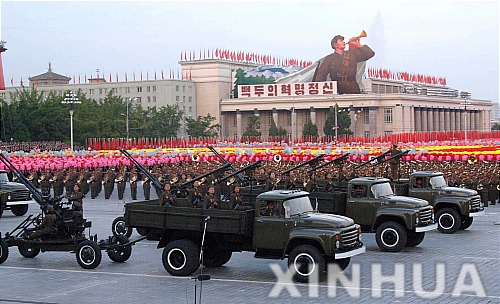The ticking Korean bomb
The ISIS and terrorist attacks in Europe grab regular headlines while a quiet bomb ticks in northeast Asia. The threat is not misplaced, considering nuclear weapons and ballistic missiles are at the command of a 33-year old authoritarian leader of North Korea, Kim Jong-un.
Korea is the last divided nation on the planet. Unification may be a far-fetched dream but de-nuclearisation and de-militarisation are other matters.
North Korea is the only country to have tested nuclear weapons in the 21st century, the fourth as recent as January 2016. The country’s missile programme is ominous. Reports suggest that after the collapse of the Soviet Union, North Korea’s ballistic missile capability has made it one of the most active exporters of complete ballistic missile systems.
North Korea purportedly has 1,000 missiles of varying capability. Rumours of weapons of mass destruction (WMD) are rife, though not verified. In February 2016, it launched a satellite into the earth’s orbit. The claims for peaceful purposes are countered by defence analysts saying it is a cover for an ICBM (intercontinental ballistic missile) test. Japan threatened to shoot it down if it crosses Japanese territory. Fearing possible nuclear repercussions, China quickly stepped in with a global plea to refrain from any action.
Japan’s strong reaction is a chilling reminder of Korean history, which was a harsh, mostly military-ruled Japanese colony between 1910 and 1945. After Japan surrendered to the Allies at the end of World War II, Korea was ‘occupied’ by the victorious countries – south by America and north by the Soviet Union. No consensus for a unified country could be reached. In 1948, two governments were established, each claiming to be a government of the whole Korea.
Two years down, horror struck when North Korea invaded the South in 1950, leading to the Korean War. The Americans supported the South while this time it was the Chinese who supported North Korea. The three-year war took the lives of three million Koreans, one million Chinese and over 50,000 Americans.
The Korean War did not end with a peace treaty, only a truce. The result is the Demilitarised Zone (DMZ) that epitomises the divided nation – a four-kilometre-wide no man’s land, stretching across 250 kilometres.
For nearly four decades after the Korean War, the peninsula remained unstable with escalated tensions. North Korea dug deep and long tunnels to move up to 30,000 soldiers per hour at one time. America continued heavy military exercises with South Korea. This was a reason for Pyongyang to further its weapons and nuclear programme.
In the early 1990s, both Koreas made a Joint Declaration. They agreed not to “test, manufacture, produce, receive, possess, store, deploy, or use nuclear weapons”.
A path-breaking initiative for peace, the Sunshine Policy, emanated from this environment of co-operation. It was initiated in 1998 by the then South Korean President, Kim Dae Jung, a Nobel Peace Prize winner. The Sunshine Policy enabled business co-operation and opened the possibility for separated family members to meet.
A 2007 regime change in South Korea led to setting aside the Sunshine Policy and, in a face of a nuclear test, adopting a harder stand towards North Korea. Meanwhile, American military exercises in South Korea continued. There are close to 30,000 American soldiers in South Korea. Reason enough for North Korea to escalate its nuclear and missile programmes, leading to more reactive measures. Fearing a nuclear test, 4,000 additional American soldiers landed in South Korea in February 2016. In March and April, North Korea claimed more long-range ballistic missile tests.
The Korean peninsula is in a quagmire. The stakeholder countries form part of the Six-Party Talks. They include both Koreas, USA, Russia, China, and Japan. Meanwhile, the United Nations Security Council announced Resolution 2270 with more sanctions.
The gravity of the tensions is reflected in recent reactions of China and Russia, historical supporters of North Korea. In March 2016, Chinese Foreign Minister Wang Yi, and his Russian counterpart, Sergey Lavrov, reiterated the need to re-open the Six-Party Talks and implement UN Resolution 2270. It indicated that ‘all’ parties should show restraint. This hints that the deployment of the U.S. Terminal High Altitude Area Defense (THAAD), an anti-ballistic missile system, may have repercussions that will sabotage the strategic balance in the region. Subsequently, John Kerry, US Secretary of State, made a statement after nearly four weeks, mentioning the possibility of a peace treaty and speaking highly of China’s support.
Recently, on the sidelines of the Nuclear Security Summit, Park Geun-hye, President of South Korea, had a tripartite meeting with President Obama and President Abe of Japan. Meanwhile, North Korea fired a submarine-based ballistic missile in mid-April. In early May, North Korea held a huge Party Congress after nearly four decades. Kim Jong-un made an impressive statement about a foreign policy of ‘independence, peace and friendship’. At the same time, he reiterated not to use nuclear weapons unless nuclear-armed “aggressive hostile forces” encroach upon his country’s sovereignty.
The moot point is, no one knows what boundaries Kim Jong-un considers ‘his country’. His mocking stance and laughter in officially released videos after every nuclear test or missile launch cannot be ignored either.
Neelima MATHUR
The article firstly appeared in “The Statesman” on May 18, 2016






















































